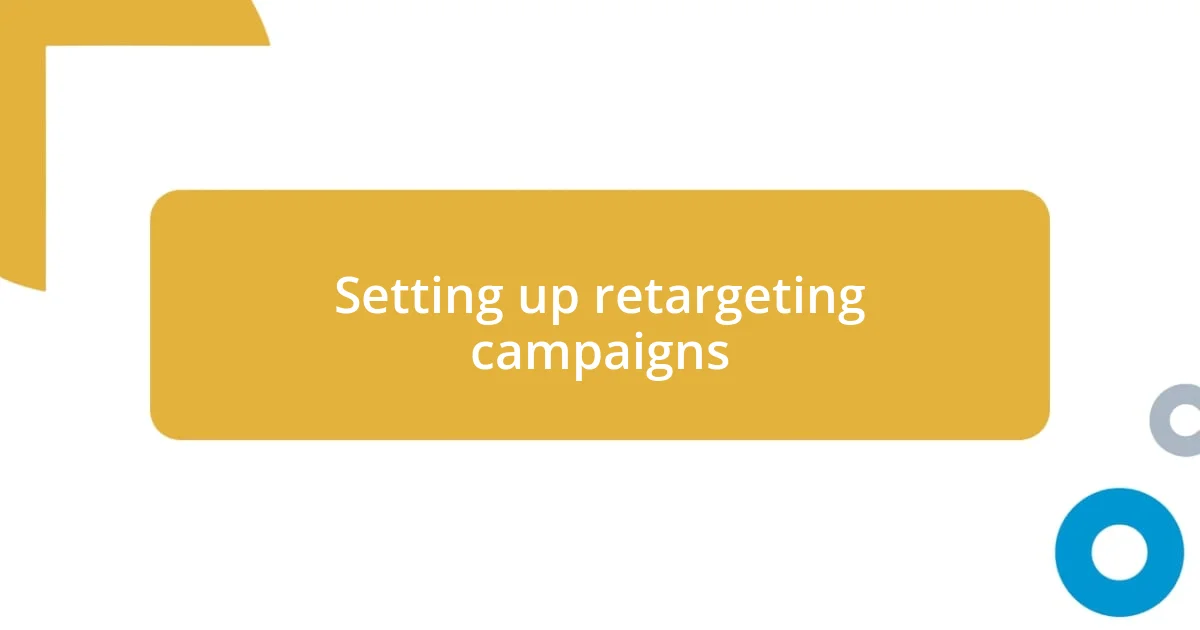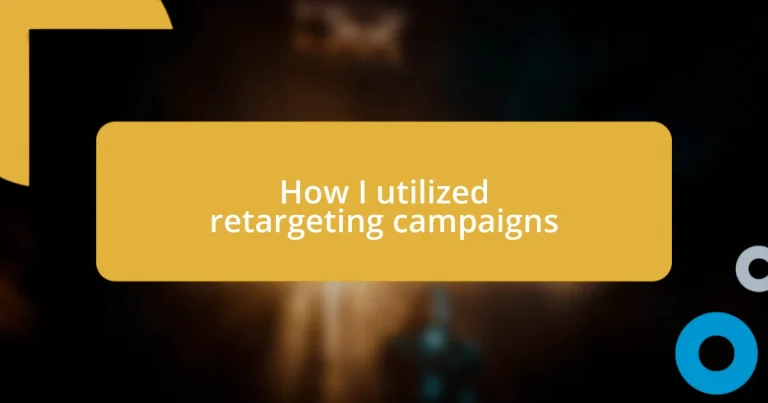Key takeaways:
- Retargeting campaigns enhance brand recall and conversion rates by reminding potential customers of their previous interest in products.
- Segmenting audiences based on behavior and demographics leads to more personalized and effective advertising.
- Data-driven optimization, including measuring performance metrics and adjusting ad timing, significantly improves campaign success.

Understanding retargeting campaigns
Retargeting campaigns are a powerful tool in digital marketing. I remember the first time I set up a retargeting ad for a client; it was like finding the key to a hidden room in a house. Suddenly, those who had visited the website were seeing our ads everywhere, prompting them to return and complete their purchases. Isn’t it fascinating how a simple nudge can rekindle interest?
The core idea behind retargeting is straightforward: it focuses on individuals who have already engaged with your brand. I’ve often wondered, why do some brands succeed while others fail? I realized that it often boils down to their ability to stay on the radar of potential customers. The emotional pull of seeing a familiar brand can reignite a connection that might have otherwise been lost.
One of the striking aspects of retargeting is its ability to enhance brand recall. When I looked at analytics after a retargeting campaign, I was genuinely surprised by how many people returned, having been reminded of what they once considered. Isn’t it amazing how a visual reminder can create a bridge back to an earlier interest? In my experience, this technique transforms potential interest into concrete action, making it essential in today’s competitive landscape.

Importance of retargeting in marketing
Retargeting plays a crucial role in marketing because it taps into the existing interest of potential customers. I recall a campaign where we targeted visitors who had left items in their shopping cart. The thrill of seeing those conversions spike when we reminded them of those forgotten items was incredibly validating. It highlighted how even a gentle nudge could transform hesitation into action, reminding me of how important it is to meet customers where they are in their decision-making process.
- It reinforces brand recognition.
- It increases the likelihood of conversions.
- It helps maintain ongoing engagement with potential customers.
- It allows for personalized advertising based on user behavior.
- It can significantly lower customer acquisition costs by targeting warm leads.

Setting up retargeting campaigns
Setting up retargeting campaigns can initially feel daunting, but it’s quite straightforward once you break it down. I remember when I first navigated the intricacies of ad platforms like Google Ads and Facebook Ads. It was a little overwhelming, but I found clear guides and tutorials that were incredibly helpful. The key steps include defining your audience, choosing the right channels, and creating compelling ads that resonate.
I can’t stress enough how vital it is to set proper goals for your retargeting campaign. Do you want to recapture abandoned carts or re-engage past customers? I learned this the hard way when I realized that my ads were too broad, lacking the focus needed to drive conversions. Once I narrowed down my objectives, I could tailor my ads more effectively, leading to improved results.
Additionally, segmenting your audience is crucial. Based on my experience, this means classifying visitors into groups, such as those who viewed specific products or those who spent a certain amount of time on your site. I often found that creating tailored messages for each segment increased engagement dramatically. Establishing a systematic approach can make your retargeting efforts much more potent.
| Step | Description |
|---|---|
| Define Audience | Identify target segments based on their interactions with your site. |
| Set Goals | Determine what you want to achieve with your campaign. |
| Create Compelling Ads | Design engaging ads that reflect the interests of your audience. |
| Segment Audience | Group visitors by behavior for more personalized messaging. |

Analyzing audience segmentation strategies
Understanding audience segmentation strategies can dramatically enhance the effectiveness of your retargeting campaigns. I’ve often found that simply dividing my audience into distinct groups—like frequent visitors versus one-time browsers—provided me with sharper insights about their behaviors. It’s fascinating how this classification allows for tailored messaging. Have you ever noticed how much more relevant an ad feels when it speaks directly to your interests?
Another approach I typically employ involves demographic segmentation. For instance, when I ran a campaign targeting young professionals, I tailored the visuals and language to align with their lifestyle. The result? A noticeable uptick in engagement! It really opened my eyes to the importance of not just knowing who my audience is, but understanding what drives them. By aligning my messaging with their specific needs and preferences, I was able to forge a deeper connection.
I also delve into psychographic segmentation, considering my audience’s values and interests. By analyzing their social media activity and purchase history, I shaped campaigns that resonated on a personal level. There’s an indescribable satisfaction in hitting the mark so closely that it feels like you’re speaking directly to each individual. Have you tried digging deeper into what makes your audience tick? It just might unlock new pathways for engagement!

Crafting effective ad creatives
When I think about crafting effective ad creatives, one principle stands out: clarity is key. I remember one particular campaign where I opted for minimalist designs. The result? A noticeable increase in click-through rates. Somehow, less clutter allowed my audience to focus on the message rather than getting distracted by flashy graphics. Have you ever experienced that moment of clarity when everything just clicks?
Another aspect I’ve found essential is emotional resonance. In one campaign targeting parents, I shared a relatable story about the struggles of balancing work and family life. This personal touch not only humanized my brand but also fostered a connection. It’s interesting how a well-timed emotional appeal can break through the noise and lead to meaningful engagement. What memories or emotions do your products evoke?
Finally, testing different creatives has been a game-changer for me. I often run A/B tests on various visuals and copy to see what truly resonates with my audience. I can’t tell you how many times I’ve been surprised by the results—it’s like discovering hidden gems! It’s empowering to know that every test can inform my approach, ultimately driving higher conversions. Have you taken the leap to experiment with your creatives? Trust me, the insights are worth it!

Measuring campaign performance metrics
Measuring the performance of my retargeting campaigns has always been an eye-opening journey. One method I often use is tracking key metrics like click-through rates (CTR) and conversion rates. For instance, there was a specific campaign where I noticed a drop in CTR despite high visibility. It made me realize I needed to reassess my ad’s appeal and tweak the messaging to better resonate with my audience’s current interests. Have you ever found yourself rethinking your approach when numbers don’t align with your expectations?
I also pay close attention to engagement metrics across different platforms. While analyzing data from one particular campaign, I observed significant activity coming from mobile users, which prompted me to optimize the user experience on that device. The shift not only improved my engagement rates but also deepened my connection with my audience. Isn’t it fascinating how fine-tuning your strategy based on analytics can lead to immediate perks in performance?
Lastly, I’m a firm believer in utilizing post-campaign analysis. After wrapping up a recent initiative, I dove deep into the data to explore which segments performed best and why. It was insightful to see how particular audience segments reacted differently to various offers and creatives, unlocking a treasure trove of information for future campaigns. How often do you revisit your past campaigns to extract lessons that could drive your future successes? It’s a practice that’s paid off for me time and again!

Optimizing retargeting for better results
Optimizing retargeting campaigns is all about understanding your audience’s journey. In one instance, I realized that segmenting my audience based on their previous interactions led to much more tailored ads. I could almost feel the difference in engagement, as personalized ads resonated better with users. Have you noticed how a tailored message can feel like a one-on-one conversation rather than just another advertisement?
Moreover, utilizing frequency caps has been crucial in preventing ad fatigue. I remember running a campaign where I didn’t set these caps, which resulted in potential customers feeling overwhelmed by seeing the same ad too often. The experience became a lesson in balance—while it’s important to maintain visibility, there’s a fine line between presence and annoyance. Isn’t it interesting how a small adjustment can dramatically improve reception?
Lastly, timing plays a significant role in my retargeting strategies. I’ve found that serving ads shortly after a user’s initial interaction yields the best results. For example, after a potential customer browsed for running shoes, I’d send a well-timed reminder about them during their evening downtime. It’s like being there right when they think, “I need to make that purchase.” Have you considered how the timing of your ads might strengthen connections and push conversions?














